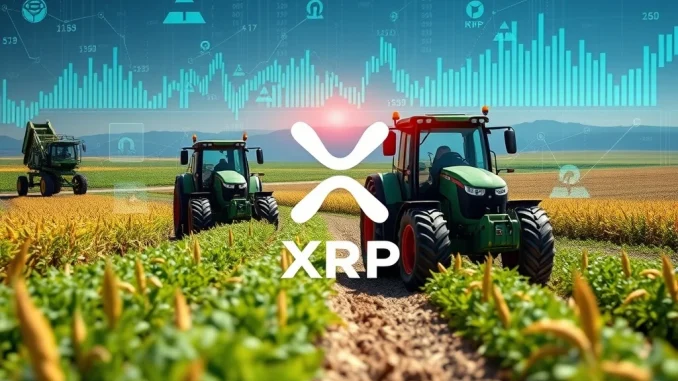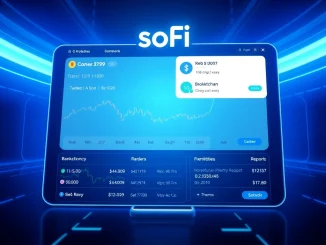
The world of finance is constantly evolving, and at the forefront of this revolution is blockchain technology. Today, we delve into a groundbreaking development that positions the XRP Ledger as a pivotal infrastructure for national economic growth. A new initiative by fintech firm VERT is set to transform Brazil’s capital markets, leveraging the XRP Ledger to tokenize a substantial $130 million Agribusiness Receivables Certificate (CRA). This move isn’t just a technical feat; it’s a strategic leap towards a more transparent, efficient, and accessible financial ecosystem, with a staggering $500 million expansion pipeline already in sight for tokenized private credit workflows.
Unlocking Value with XRP Ledger Technology
Fintech firm VERT has officially launched a cutting-edge blockchain-based platform, harnessing the power of the XRP Ledger (XRPL) to digitize Brazil’s capital markets. This ambitious project begins with the tokenization of a BRL 700 million (approximately $130 million) Agribusiness Receivables Certificate (CRA). This initiative marks a significant step towards modernizing securitization and fund operations in Brazil. By recording transactions on the XRPL, the platform promises to deliver unparalleled transparency, enhance transaction speed, and bolster security within the financial system. The XRPL’s inherent capabilities, such as its low fees and high throughput, are critical for facilitating the near real-time traceability required in modern credit markets.
The Transformative Potential of Tokenized Assets
What exactly are these tokenized assets, and why are they so significant? In this context, the CRA represents tokenized cash flows directly tied to agricultural production. By converting these traditional assets into digital tokens on the blockchain, VERT enables fractional ownership, making previously illiquid private credit assets more accessible to a broader range of investors. This diversification of access is a game-changer, reducing friction in capital allocation and opening new avenues for investment. The solution integrates the XRPL EVM Sidechain, which brings Ethereum-compatible smart contract functionality into play, automating reporting and streamlining operational workflows. This blend of XRPL’s efficiency and EVM’s programmability creates a robust framework for digital finance.
Revolutionizing Private Credit Markets in Brazil
The implications of this development extend far beyond just agribusiness. Ripple’s Managing Director for LATAM, Silvio Pegado, emphasized the broader economic impact, highlighting the XRP Ledger’s potential to serve as foundational infrastructure for national growth by digitizing financial systems. The platform’s technical architecture is designed to support seamless cross-border transactions, a crucial feature for global private credit markets where liquidity and speed are paramount. Traditional settlement systems can take days, but the XRPL’s deterministic finality — confirming transactions in a mere four seconds — offers a decisive advantage, drastically improving settlement times and operational efficiency for all participants in the private credit sector.
What Does This Mean for the Agribusiness CRA Sector?
The $130 million Agribusiness CRA in Brazil serves as a vital pilot phase for VERT’s ambitious vision. With a $500 million pipeline expected to expand to other asset classes and emerging markets, this initiative sets a precedent for how agricultural finance can evolve. VERT’s Director of Digital Assets, Gabriel Braga, noted the platform’s ability to capture operational events with granular detail, significantly reducing latency between transaction execution and record-keeping. This level of detail and immediate recording ensures unparalleled transparency and trust within the agribusiness sector, fostering a more dynamic and efficient market for agricultural finance instruments.
Blockchain Finance: A Catalyst for Modernization
Analysts are closely watching VERT’s strategy, which aligns perfectly with the burgeoning trends in blockchain finance. Leveraging blockchain’s inherent programmability and interoperability, this initiative is poised to reshape traditional asset classes. While the potential for disruption is immense, challenges such as regulatory uncertainty and the ongoing need for standardized frameworks persist. However, the XRP Ledger’s unique architecture, which balances decentralization with robust compliance tools like transaction traceability, positions it as a highly competitive and sustainable alternative to proof-of-work blockchains, often criticized for their energy consumption and governance complexities. This project demonstrates the practical application of blockchain in disrupting traditional lending paradigms, with the XRP Ledger acting as a foundational layer.
Navigating Challenges and Charting the Future
While VERT has successfully secured partnerships with prominent Brazilian banks and credit platforms, scaling the projected $500 million pipeline will require meticulous adaptation to diverse regulatory environments. A critical factor influencing investor confidence and secondary market liquidity will be how tokenized assets are traded after their initial issuance. Although the firm has not yet detailed these post-issuance trading mechanisms, their successful implementation will be key to broader market adoption and consistent returns. The initiative validates the technical feasibility of tokenized private credit but its ultimate success hinges on widespread market acceptance and sustained performance.
A New Era of Financial Innovation
By leveraging blockchain’s inherent transparency and efficiency, VERT’s initiative significantly advances the case for tokenized finance as a powerful catalyst for capital market modernization. This project is not merely about digitizing existing processes; it’s about creating entirely new possibilities for investment, liquidity, and financial inclusion. The XRP Ledger’s role in this transformation underscores its growing importance as a global infrastructure for the digital economy, paving the way for a more connected and efficient financial future.
Frequently Asked Questions (FAQs)
What is the XRP Ledger (XRPL) and why is VERT using it?
The XRP Ledger is a decentralized, public blockchain designed for fast, low-cost transactions. VERT is using it to tokenize financial assets like the Agribusiness CRA due to its high throughput, low transaction fees, rapid settlement times (4 seconds), and built-in features that support transparency and security, making it ideal for modernizing capital markets.
What are Tokenized Assets in the context of this project?
Tokenized assets are digital representations of real-world assets (like the Agribusiness Receivables Certificate) on a blockchain. By tokenizing the CRA, VERT allows for fractional ownership, easier transferability, and increased liquidity, transforming traditional, often illiquid, financial instruments into digital, programmable assets.
How does this initiative impact Private Credit markets?
This initiative revolutionizes private credit by digitizing and streamlining the securitization process. It enables faster settlements, reduces operational friction, and provides greater transparency, making private credit assets more accessible to a wider range of investors and facilitating more efficient capital allocation within these markets.
What is an Agribusiness CRA and its significance here?
An Agribusiness CRA (Certificado de Recebíveis do Agronegócio) is a Brazilian financial instrument representing receivables from agricultural production. By tokenizing this $130 million CRA, VERT is demonstrating how blockchain can bring enhanced traceability, liquidity, and investment opportunities to the agricultural sector, serving as a pilot for future expansions.
What are the benefits of using Blockchain Finance for traditional markets?
Blockchain finance offers numerous benefits, including increased transparency, reduced transaction costs, faster settlement times, enhanced security, and the ability to enable fractional ownership of assets. It can modernize traditional financial systems by creating more efficient, accessible, and resilient markets, as demonstrated by VERT’s use of the XRP Ledger.



